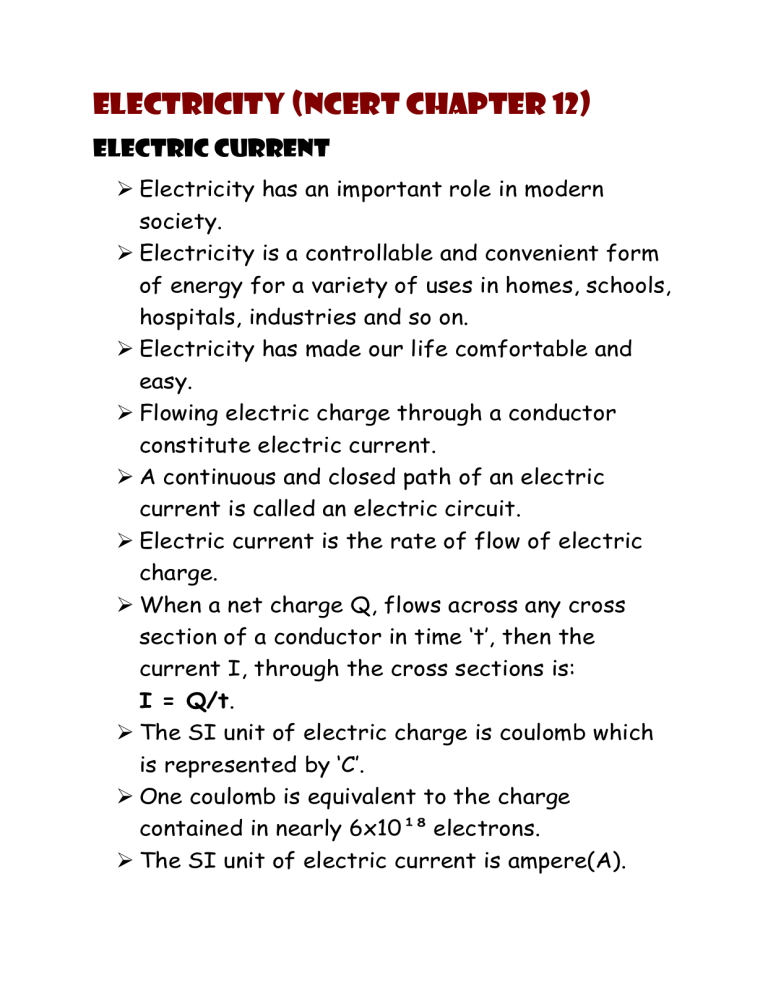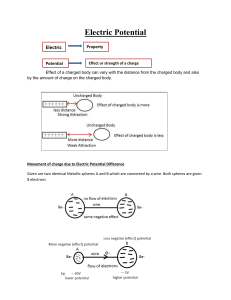
Electricity (NCERT CHAPTER 12) ELECTRIC CURRENT Electricity has an important role in modern society. Electricity is a controllable and convenient form of energy for a variety of uses in homes, schools, hospitals, industries and so on. Electricity has made our life comfortable and easy. Flowing electric charge through a conductor constitute electric current. A continuous and closed path of an electric current is called an electric circuit. Electric current is the rate of flow of electric charge. When a net charge Q, flows across any cross section of a conductor in time ‘t’, then the current I, through the cross sections is: I = Q/t. The SI unit of electric charge is coulomb which is represented by ‘C’. One coulomb is equivalent to the charge contained in nearly 6x10¹⁸ electrons. The SI unit of electric current is ampere(A). Current through a cross section of a conductor is said to be one ampere when 1 coulomb of charge flows through it in one second. 1 ampere = 1 coulomb/ 1 second Small quantities of current are expressed in milliampere (1mA=10-3A) or in microampere (1µA=10-6). ELECTRIC POTENTIAL AND POTENTIAL DIFFERENCE The electric potential difference between two points in an electric circuit carrying some current is defined as the work done to move a unit charge from one point to the other. The chemical reaction within a cell generates the potential difference across the terminals of the cell. Potential difference (V) between two points = work done (W)/ Charge(Q). V= W/Q SI unit of electrical potential difference is Volt(V). One volt is the potential difference between two points in a current carrying conductor when one joule of work is done to move a charge of one coulomb from one point to the other. Therefore, 1 volt = 1 joule/ 1 coulomb The potential difference is measured by an instrument called Voltmeter. The voltmeter is always connected in parallel across the points between which the potential difference is to be measured. CIRCUIT DIAGRAM Ohm’s law Ohm’s law states, “The potential difference, V, across the ends of a given metallic wire in an electric circuit is directly proportional to the current flowing through it, provided its temperature remains the same.” V= IR or RI (mathematical relation of ohm’s law). Resistance is the property of a conductor to resist the flow of charges through it. SI unit of resistance is ohm, represented by the Greek letter Ω. Resistance of a conductor is said to be one ohm when a current of one ampere flows through the conductor by applying a potential difference of one volt across its ends. 1 ohm = 1 volt/1Ampere A good conductor is one that has low resistance. On the other hand a good insulator has very high resistance. Temperature plays a vital role in determining the resistance of a conductor. At room temperature, silver is the best conductor and copper is second best. Experimental verification of ohm’s law On increasing the value of electric current, value of potential difference also increases. The ratio V/I of the various values of the V and I at a given temperature is constant which is equal to the resistance of the conductor. The value of current is different for different resistance. FACTORS ON WHICH THE RESISTANCE DEPENDS Materials that offer a low resistance are good conductors of electricity. They allow electricity to pass though them very easily. Copper, Silver, Aluminium are good conductors. Materials that offer a higher resistance are poor conductors of electricity. They allow very less electricity to pass through them. Tungsten, Bismuth, Stainless steel are poor conductors of electricity. Materials that offer a very high resistance are insulators, they allow no electricity to pass through them. Plastic, paper, plastic, rubber, glass are insulators. The resistance of a conductor is directly proportional to the length of the conductor. Resistance ∝ Length of conductor R ∝ I The resistance of a conductor is inversely proportional to the area of cross section of the conductor. Resistance ∝ 1/ area of cross section R ∝ 1/A Resistance of a conductor depends on the nature of material of the conductor. Electrical resistivity Resistance of a uniform metallic conductor is directly proportional to its length(l), i.e., resistance µ length of the conductor Rµl. Resistance of a unform metallic conductor is inversely proportional to the area of cross section (A). i.e., Rµ 1/ area of cross section Rµ 1/A R = ρ l/A Where ρ(rho) is a constant of proportionality and is called the electrical resistivity of the material of the conductor. The SI unit of resistivity is Ωm. The metals and alloys have very low resistivity in the range of 10^-8 Ωm to 10^-6 Ωm. They are good conductors of electricity. Insulators like rubber and glass have resistivity of the order of 10^12 to 10^17 Ωm. Combination Of Resistors in Series We connect a number of resistors in two waysSeries combination and Parallel combination. Three resistors having resistances R1, R2, and R3 respectively, are joined end to end in an electric circuit, here the resistors are said to be connected in series. In a series combination of resistors, the current in the same in every part of the circuit or the same current flows through each resistor. The total potential difference across a combination of resistors in series is equal to the sum of potential difference across the individual resistor, i.e., V = V1 + V2+ V3



